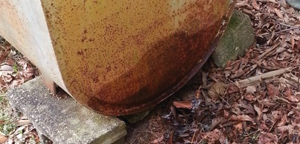Is It Time To Replace Your Oil Tank?
By replacing your current oil tank now, you can potentially avoid an environmental disaster and save tens of thousands of dollars associated with the clean up of an oil spill.
Proactive replacement gives you time to select the best replacement option for you, as well as add value to your home’s resale value.
Replacing an oil tank that has been deemed “risky” by a professional is a smart move. This simple action now could prevent a very expensive problem later. It is also a good investment for your home and family.
Dangers of oil leaks:
- Oil leaks have limited warning signs and are unpredictable
- According to the Maryland Department of the Environment, the average oil leak clean up cost ranges from $10,000 - $50,000
- Cost for oil tank leaks are the homeowner's responsibility
- Oil leaks are environmentally hazardous
- A simple tank replacement can save you lots of time and money
Schedule Your Free Energy Consultation
Signs That It's Time To Replace Your Heating Oil Tank:
There is no way to predict or know exactly when an oil leak will occur. Oil tanks corrode from the inside out, making it hard to determine if a tank is about to leak or needs to be replaced. The tank’s age is the best way to determine if it is time for replacement. If you are lucky, there are also some telltale signs that a tank is nearing the end of its useful life.
If you've noticed any of the signs listed below, it may be time to replace your oil tank.

Age of your tank
The average oil tank has a lifespan of about 15 years. As your tank ages, the risk of a costly oil leak increases. Although you may not notice other signs of deterioration, there could be internal weak spots or damage inside your tank as it gets older that could cause it to leak.

Rust and wet spots
Rust on the outside of our tank could be an indicator of weak spots in the walls of your tank. If the inside of your tank starts to rust, it could create a build-up of sediment on the bottom of your tank that can lead to clogged lines.

Leaning or missing legs
If the legs of your tank have gotten weak and it has started to lean, it is time to replace your tank. A collapsing leg on an old tank could easily cause a break in your tank resulting in a costly leak. Your tank should also be evenly supported on all four legs, without using blocks or other means of support.

Signs of a prior leak
If there are wet spots or stains on or around your tank, there is a good chance your tank has leaked in the past. Prior leaks indicate that there could be weak spots in the seams or walls of your tank, which could lead to more leaks in the future.

Fill and vent pipes are different sizes
If your fill and vent pipes are different sizes, it's possible that your tank cannot ventilate properly when being filled. Without proper ventilation, pressure can build up inside your tank and cause your seams to weaken, or can even cause your tank to burst.
Why Is It Important To Replace My Oil Tank?
Oil tanks have a limited lifespan. According to the Maryland Department of the Environment (MDE), it is advisable to replace your oil tank every 15 years. As the age of your tank approaches 15 years, the potential for a dangerous oil leak increases.
If an oil tank leaks, the cleanup and any liabilities associated with the leak are the responsibility of the homeowner. Environmental cleanup is required to remove any oil from the surrounding soil, and can cost anywhere between $10,000 and $50,000 for an above ground tank.
If you are unsure of the condition of your oil tank and would like to speak with one of our expert energy consultations to get a free estimate for a new tank, fill out the form on this page or call us at 888-828-1485.
